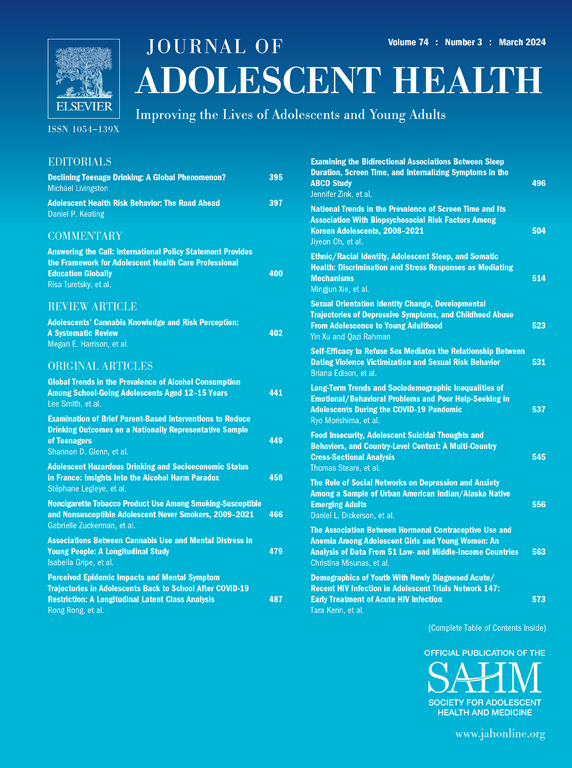年轻人愿意在网上干预强奸神话:一个模拟的社交媒体实验。
IF 4.5
2区 医学
Q1 PEDIATRICS
引用次数: 0
摘要
目的:社交媒体提供了干预青少年和年轻人有害的强奸神话信仰的机会,例如通过数字旁观者干预。方法:我们进行了一项数字实验,以检验年轻人在模拟社交媒体环境中干预强奸神话评论的意愿。参与者为18-25岁的青少年和年轻人(n = 712) (M = 22.14, SD = 1.92)。参与者随机观看以下社交媒体帖子:(1)强奸神话评论,(2)强奸神话评论加上旁观者干预评论,或(3)只有中立评论的控制条件。然后,参与者报告了干预的意愿、性别刻板印象的同意、酒精强奸神话的接受程度以及旁观者行为的规范性。结果:强奸神话评论(有或没有旁观者评论)导致参与者更愿意干预。酒精性强奸神话的接受度、旁观者行为的感知规范性和性别(女性vs.男性)都是这一关系的显著调节因子。易受酒精性强奸迷思影响的参与者和男性不太愿意介入强奸迷思和强奸迷思+旁观者的情况。那些认为旁观者的行为不太正常的参与者更愿意干预只有强奸神话的情况。讨论:本研究探讨了接触社交媒体上有害的强奸神话评论的年轻人的态度。未来的研究应该继续这项工作,特别是寻求减少酒精强奸神话和性别的不良节制效应的方法。本文章由计算机程序翻译,如有差异,请以英文原文为准。
Young People Are Willing to Intervene Against Rape Myths Online: A Simulated Social Media Experiment
Purpose
Social media present opportunities to intervene on harmful rape myth beliefs among adolescents and young adults, such as through digital bystander intervention.
Methods
We conducted a digital experiment to examine young peoples' willingness to intervene on rape myth comments in a simulated social media environment. Participants were adolescents and young adults (n = 712) aged 18–25 years (M = 22.14, SD = 1.92). Participants randomly viewed social media posts with the following: (1) rape myth comments, (2) rape myth comments with bystander intervention comments, or (3) control condition with only neutral comments. Participants then reported willingness to intervene, gender stereotype agreement, alcohol rape myth acceptance, and perceived normativity of bystander behavior.
Results
Rape myth comments (with or without bystander comments) led to greater willingness to intervene among participants. Alcohol rape myth acceptance, perceived normativity of bystander behavior, and gender (women vs. men) were all significant moderators of this relationship. Participants susceptible to alcohol rape myths and those who were men were less willing to intervene in the rape myth and rape myth + bystander conditions. Participants who perceived bystander behavior to be less normal were more willing to intervene in the rape myth-only condition.
Discussion
This study explored attitudes of young people exposed to harmful rape myth comments on social media. Future studies should continue this work, especially pursuing ways to reduce undesirable moderation effects of alcohol rape myths and gender.
求助全文
通过发布文献求助,成功后即可免费获取论文全文。
去求助
来源期刊

Journal of Adolescent Health
医学-公共卫生、环境卫生与职业卫生
CiteScore
10.40
自引率
3.90%
发文量
526
审稿时长
46 days
期刊介绍:
The Journal of Adolescent Health is a scientific publication dedicated to enhancing the health and well-being of adolescents and young adults. Our Journal covers a broad range of research topics, spanning from the basic biological and behavioral sciences to public health and policy. We welcome a variety of contributions, including original research papers, concise reports, literature reviews, clinical case reports, opinion pieces, and letters to the editor. We encourage professionals from diverse disciplines such as Anthropology, Education, Ethics, Global Health, Health Services Research, Law, Medicine, Mental and Behavioral Health, Nursing, Nutrition, Psychology, Public Health and Policy, Social Work, Sociology, and Youth Development to share their expertise and contribute to our mission of promoting adolescent health. Moreover, we value the voices of young individuals, family and community members, and healthcare professionals, and encourage them to submit poetry, personal narratives, images, and other creative works that provide unique insights into the experiences of adolescents and young adults. By combining scientific peer-reviewed research with creative expressions, our Journal aims to create a comprehensive understanding of the challenges and opportunities in adolescent and young adult health.
 求助内容:
求助内容: 应助结果提醒方式:
应助结果提醒方式:


